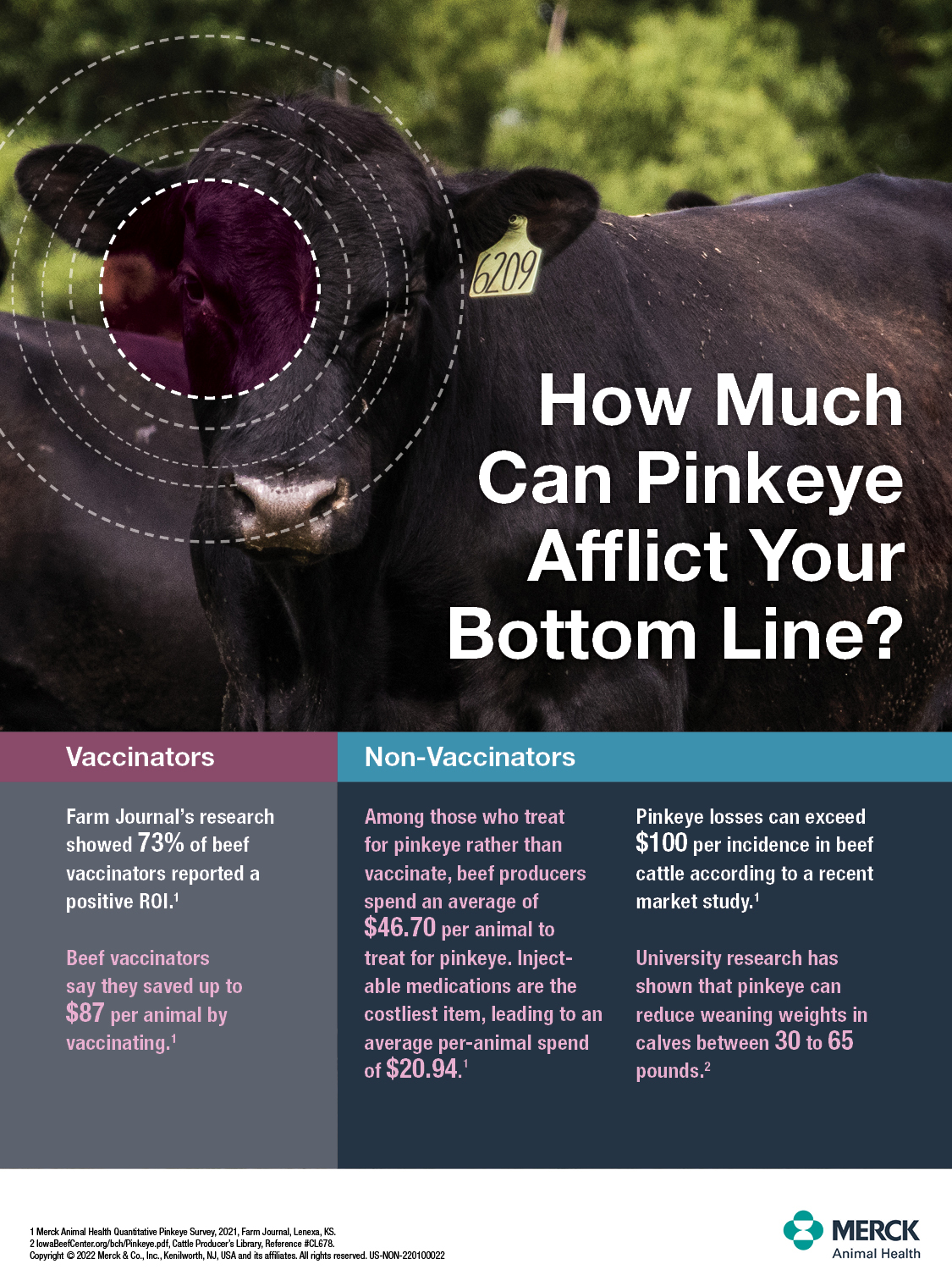Is Pinkeye Afflicting Your Client’s Bottom Line?
Download PDF
Taking action before an outbreak might be the best medicine for all.
Let’s get right to it. According to Merck Animal Health research conducted in 2021 by Farm Journal, 73% of beef producers who vaccinated against pinkeye reported a positive return on investment (ROI). They say vaccinating, instead of waiting for an outbreak to occur, saved them up to $87 per animal. That same study revealed dairy producers, who waited to treat after a pinkeye outbreak, reported losing up to $352 per animal.¹
Animals with pinkeye are commonly discounted when sold at auction. That discount averages $10-12 per hundred pounds of body weight according to market research.2 Other costs are related to reduced weight gain. A study conducted at Iowa State University concluded that the weaning weights of beef calves diagnosed with pinkeye compared to those not diagnosed with pinkeye varied averaged 13 kg (28.6 lbs.)³
It shows an effective pinkeye prevention program is important because the cost of pinkeye infection can be extremely high in several areas of an operation. The cost of disease, in general, can be devastating. In 2016, The Ohio State University College of Food, Agricultural, and Environmental Sciences published their own article stating, “A comprehensive vaccination program including infectious bovine keratoconjunctivitis (pinkeye), the respiratory viral diseases IBR and BVD, parasite control, and basic biosecurity practices are all exceptionally important in improving the cow’s or calf’s ability to fight off any disease process.”4 Simply put, a solid vaccination strategy can save ROI, as well as time and frustration.
So, what does a good preventive pinkeye plan look like? In the words of Dustin Loy, associate professor of Veterinary Diagnostic Microbiology, Nebraska Veterinary Diagnostic Center, University of Nebraska-Lincoln, that might differ from operation to operation, but it all begins with vaccination. “The ideal vaccine strategy would involve consultation with the producer to fully understand their production systems in addition to disease history and current vaccine and prevention programs. This combined with a herd visit or investigation to understand potential risk factors and causes can also be helpful to develop a plan that helps meet the producer’s goals.”5
Work with your clients to determine the best plan of action to provide protection against the greatest number of strains of Moraxella bovis and M. bovoculi.
For more information on managing pinkeye, visit https://www.bovinevetonline.com/news/education/pinkeye-prevention-preferred
For more information on pinkeye vaccination, visit StopCattlePinkeye.com
¹ Merck Animal Health Quantitative Pinkeye Survey, 2021, Farm Journal, Lenexa, KS.
2 University of Tennessee Institute of Agriculture, 2007, Tennessee dairy cattle pest control profile, https://ipmdata.ipmcenters.org/documents/cropprofiles/TNdairycattle.pdf (Jan. 25, 2022).
3 Funk, L & O'Connor, Annette & Maroney, M & Engelken, Terry & Cooper, V.L. & Kinyon, J & Plummer, P. (2009). A randomized and blinded trial to assess the efficacy of an autogenous vaccine to prevent naturally occurring infectious bovine keratoconjunctivis (IBK) in beef calves. Vaccine. 27. 4585-90. 10.1016/j.vaccine.2009.05.082.
4 Michelle Arnold, DVM, Pinkeye in Cattle, Ohio BEEF Cattle Letter, 2029 Fyffe Road, Columbus, Ohio, The Ohio State University, 2016,
https://u.osu.edu/beef/2016/05/25/pinkeye-in-cattle/#more-1920, (Dec. 6, 2021).
5 Dustin Loy, Associate Professor of Veterinary Diagnostic Microbiology, Nebraska Veterinary Diagnostic Center, University of Nebraska-Lincoln.








